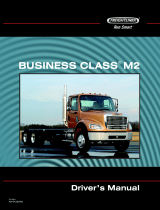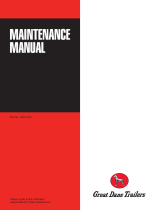Page is loading ...

AIR PRESSURE BALANCE &
THRESHOLD PRESSURE TESTS
GENERAL INSTRUCTIONS:
1. Number the axle and each brake on the axle of the vehicle being tested using the illustration.
2. All testing should be performed using both increasing (INC) and decreasing (DEC) air pres-
sure and using our instructions.
3. When performing the Air Brake Pressure Balance Tests the pressure from only one chamber
of a tandem can be used when the same relay valve delivers pressure directly to all four
chambers on the tandem.
4. Record test results in the charts provided.
Air Pressure Balance and
Threshold Pressure Tests
®
Date: ________________________
Test Conducted By: ____________
Vehicle No: ___________________
Axle No. 1 2 __ __ __ __ __ __ __ __ __ __ __
Brake No.
1 3 __ __ __ __ __ __ __ __ __ __ __
Axle
Brake No.
2 4 __ __ __ __ __ __ __ __ __ __ __
Tractor
Dolly
Dolly
Trailer TrailerTrailer
Vehicle Manufacturer
Number Model, Year Comments
Tractor
#1 Trailer
Conv. Dolly
#2 Trailer
Conv. Dolly
#3 Trailer
VEHICLE DATA

BR.# INC DEC AVG BR.# INC DEC AVG
2
11
3
4
5
6
7
8
9
1
10
12
13
14
15
16
17
18
19
20
Foundation Brake Threshold Pressure Test
Air Brake Pressure Balance Test
5
10
15
20
25
30
40
50
60
1
23
4
5
6
7
1234567
Service Chamber Pressure at Axle
Increasing Pressures for Axle Nos. Decreasing Pressures for Axle Nos.
Trailer Control Line

VEHICLE PREPARATION FOR TESTING
1. Adjust all brakes equally using the vehicle
manufacturers procedure.
2. Secure the vehicle on a level surface by means other
than the brakes and charge the air system to governor
cut-out (approximately 120 psi). Shut off engine.
CAUTION: To avoid possible injury due to
automatic application of the parking brakes during
testing, it is recommended that the parking brakes
be mechanically caged.
3. Check the vehicle or combination for excessive air
system leakage. If the combined leakage exceeds the
limits below, repair the sources of leakage before
proceeding.
AIR BRAKE PRESSURE BALANCE TEST
Objective: To determine the air pressure differences
between the various axles of a single or
combination vehicle.
Equipment: Dual test gauge (use a gauge with a 0-150
psi range.)
Testing:
1. Perform vehicle preparation and place the vehicle dash
control valves in the normal over-the-road position.
2. If the vehicle being tested is a single unit, such as a
straight truck or bus, install one half of the dual test
gauge directly in the #1 or primary circuit delivery of
the brake valve. For tractors or combination vehicles,
install one half of the dual test gauge in the trailer
service (control) line (between tractor and trailer).
NOTE: This half of the test gauge will remain here
for the duration of the test. Install the other half of
the test gauge in a service brake chamber at axle #1.
(Procedure will be repeated at each axle of the vehicle
combination). NOTE: Test gauge connection must
be between the air chamber and any control valve,
ideally directly in or at the chamber.
Brakes Brakes Fully
Released Applied
Single
Vehicle 4 psi in 2 mins. 6 psi in 2 mins.
Tractor
w/Trailer 6 psi in 2 mins. 8 psi in 2 mins.
Tractor
w/2 Trailers 8 psi in 2 mins. 10 psi in 2 mins.
3. Gradually apply the brakes via the brake valve and
record the axle pressure in the increasing (INC) column
of the axle #1 when brake valve primary delivery or
trailer service (control) line pressure is at 5, 10, 15,
20, 25, 30, 40, 50 and 60 psi. Repeat procedure for
each axle of the vehicle combination and record
pressure readings on the chart. (See partial example.)
IMPORTANT: Readings during this phase of the
procedure should be taken with increasing air
pressure only. Do not over apply and then release, as
an inaccurate reading will occur. Release brakes fully
and re-apply, if pressure is over applied.
4. Repeat the procedure using decreasing air pressure.
Fully apply (75 psi application min.) the service brakes
then gradually release and record the axle pressure
in the decreasing (DEC) column of the appropriate
axle when brake valve primary delivery or trailer
service (control) line pressure is at 60, 50, 40, 30, 25,
20, 15, 10 and 5, respectively. Repeat the procedure
for each axle and record the pressure readings on the
chart.
EXAMPLE:
IMPORTANT: Readings during this phase of the
procedure should be taken with decreasing air
pressure only. Do not under shoot the pressure and
partially reapply pressure as an inaccurate reading
will result. Fully apply the brakes and exhaust down
to the specified pressure.
5. When testing is complete, uncage the parking brakes
unless you are proceeding to FOUNDATION BRAKE
THRESHOLD PRESSURE TESTING.
Air Brake Pressure Balance Test

EXAMPLE:
Foundation Brake Threshold Pressure Test
7. When testing is complete, uncage the parking
brakes.
RECOMMENDATIONS:
Bendix recommends that all brake threshold pressures
for all axles (average calculated value from the test
results) be within a 2 psi range. This is to enable the
brake force distribution to be within acceptable limits,
especially at low brake application pressures. Industry
studies have indicated that 80% of all brake applications
made in actual service are below 20 psi.
For pressure balance, on increasing pressures we
recommend that the pressure recorded at each axle be
within 2 psi of one another for trailer control line pressures
of 10 to 40 psi. The decreasing pressures recorded
should also be within 2 psi of one another in this pressure
range. For axles fitted with special valves which enable
the threshold pressure recommendation to be achieved
or which proportion or limit the delivery to the chambers
this recommendation is not valid. Under these conditions
the specific application must be analyzed in more detail
to understand the brake distribution.
There are many factors that affect vehicle brake balance.
Balancing the brake threshold pressures and the
pressure at the chambers of all axles are important
factors in achieving brake balance. However, this does
not necessarily ensure even lining wear or brake force
distribution. Consideration must also be given such
factors as tire size, brake size, brake type, friction
material and others.
NOTE: The difference recorded in these tests can be
attributed to specific vehicle design considerations.
Before any brake system modification are made the test
data should be reviewed by both the vehicle OEM and
our Engineering Departments.
FOUNDATION BRAKE THRESHOLD
PRESSURE TESTING
Objective: To determine the air pressure required to
make and release contact between the lining
and drum at each foundation brake on the
vehicle.
Equipment: Test gauge (use a gauge with a 0-60 psi
range.)
Important: A low range (0-60 psi) pressure gauge is
required for accurate data for the threshold
pressure test. Using a higher range (0-100,
or 0-150 psi) gauge can result in bad data.
Testing:
1. Perform the vehicle preparation and place the vehicle
dash controls in the normal over-the-road position.
2. If the vehicle being tested is a single unit, such as a
straight truck or bus, install the test gauge directly in
the #1 or primary circuit delivery of the brake valve.
For tractors or combination vehicles, install the test
gauge in the trailer service (control) line (between
tractor and trailer).
3. Raise the axle until tires (wheel ends) are no longer
in contact with the floor.
4. While manually rotating a wheel, gradually make a
service brake application as registered on the gauge
until braking torque (drag) occurs. Note the gauge air
pressure and record it in the increasing (INC) column
for the appropriate brake in the chart.
5. Increase service air pressure to 40 psi. While
gradually decreasing the air pressure at the gauge,
attempt to rotate the wheel. Note the gauge air
pressure at which the wheel can be freely rotated and
record that pressure in the decreasing (DEC) column
for the appropriate brake in the chart.
6. Add the pressure recorded in the increasing (INC)
and decreasing (DEC) columns together then divide
by two. Record that value in the average (AVG)
column for the appropriate brake. This average is the
threshold pressure for that brake.
For example: If the number in the increasing column
was 9 and the number in the decreasing column
was 3, then 9 +3 = 12, 12÷2 = 6, and 6 is recorded in
the average column.
BW1555 © Bendix Commercial Vehicle Systems LLC 11/2002 Printed in U.S.A.
BR.# INC DEC AVG BR.# INC DEC AVG
2
11
1
12
9
36
8
3.5
6.5
/



